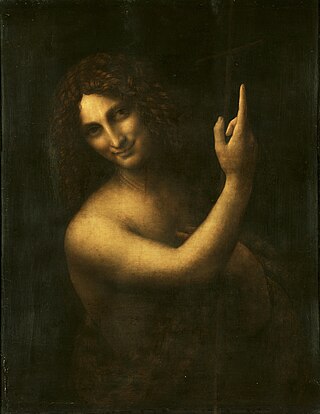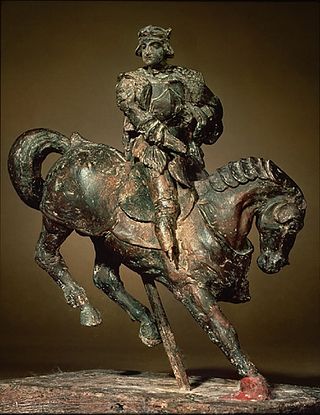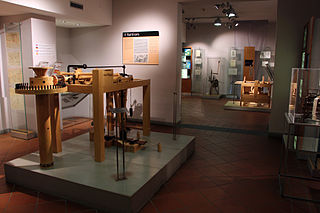
Leonardo di ser Piero da Vinci was an Italian polymath of the High Renaissance who was active as a painter, draughtsman, engineer, scientist, theorist, sculptor, and architect. While his fame initially rested on his achievements as a painter, he has also become known for his notebooks, in which he made drawings and notes on a variety of subjects, including anatomy, astronomy, botany, cartography, painting, and paleontology. Leonardo is widely regarded to have been a genius who epitomized the Renaissance humanist ideal, and his collective works comprise a contribution to later generations of artists matched only by that of his younger contemporary Michelangelo.

The Codex Leicester is a collection of scientific writings by Leonardo da Vinci. The codex is named after Thomas Coke, Earl of Leicester, who purchased it in 1717. The codex provides an insight into the mind of the Renaissance artist, scientist and thinker, as well as an exceptional illustration of the link between art and science and the creativity of the scientific process.

The Biblioteca Ambrosiana is a historic library in Milan, Italy, also housing the Pinacoteca Ambrosiana, the Ambrosian art gallery. Named after Ambrose, the patron saint of Milan, it was founded in 1609 by Cardinal Federico Borromeo, whose agents scoured Western Europe and even Greece and Syria for books and manuscripts. Some major acquisitions of complete libraries were the manuscripts of the Benedictine monastery of Bobbio (1606) and the library of the Paduan Vincenzo Pinelli, whose more than 800 manuscripts filled 70 cases when they were sent to Milan and included the famous Iliad, the Ilias Picta.

The Vitruvian Man is a drawing by the Italian Renaissance artist and scientist Leonardo da Vinci, dated to c. 1490. Inspired by the writings of the ancient Roman architect Vitruvius, the drawing depicts a nude man in two superimposed positions with his arms and legs apart and inscribed in both a circle and square. It was described by the art historian Carmen C. Bambach as "justly ranked among the all-time iconic images of Western civilization". Although not the only known drawing of a man inspired by the writings of Vitruvius, the work is a unique synthesis of artistic and scientific ideals and often considered an archetypal representation of the High Renaissance.

The Portrait of a Musician is an unfinished painting widely attributed to the Italian Renaissance artist Leonardo da Vinci, dated to c. 1483–1487. Produced while Leonardo was in Milan, the work is painted in oils, and perhaps tempera, on a small panel of walnut wood. It is his only known male portrait painting, and the identity of its sitter has been closely debated among scholars.

Saint John the Baptist is a High Renaissance oil painting on walnut wood by Leonardo da Vinci. Likely to have been completed between 1513 and 1516, it is believed to be his final painting. Its original size was 69 by 57 centimetres.

Leonardo da Vinci (1452–1519) was an Italian polymath, regarded as the epitome of the "Renaissance Man", displaying skills in numerous diverse areas of study. While most famous for his paintings such as the Mona Lisa and the Last Supper, Leonardo is also renowned in the fields of civil engineering, chemistry, geology, geometry, hydrodynamics, mathematics, mechanical engineering, optics, physics, pyrotechnics, and zoology.

The Codex Atlanticus is a 12-volume, bound set of drawings and writings by Leonardo da Vinci, the largest single set. Its name indicates the large paper used to preserve original Leonardo notebook pages, which was used for atlases. It comprises 1,119 leaves dating from 1478 to 1519, the contents covering a great variety of subjects, from flight to weaponry to musical instruments and from mathematics to botany. This codex was gathered in the late 16th century by the sculptor Pompeo Leoni, who dismembered some of Leonardo's notebooks in its formation. It is now in the Biblioteca Ambrosiana in Milan.

Codex on the Flight of Birds is a relatively short codex from c. 1505 by Leonardo da Vinci.

Mario Taddei is an Italian academic. He is an expert in multimedia and edutainment for museums, a Leonardo da Vinci devotee and scholar, and an expert in the codexes and machines of da Vinci and ancient books of technology.

The harpsichord-viola is a hybrid musical instrument based on the designs of Leonardo da Vinci on folio 93r of the Codex Atlanticus. It's a different project from the viola organista. It is about the size of a child's toy piano. It weighs 33 pounds and straps to the musician's chest. It's unlike anything else in the orchestra. It has the strings of a violin but is played with a keyboard, and it's powered by the musician's legs as he walks. It's built with the materials that Leonardo would have had on hand, including wooden pegs and gears run by twine. In the folio of Leonardo, you can see that the instrument has a harness. So it was invented as a way to play a stringed instrument while marching. The leg pumps a wooden motor, which moves a long loop of horsehair through the instrument. When the player presses the keys, the strings move up against the loop.

Leonardo's crossbow designs are a series of shooting weapon schematics designed by Leonardo da Vinci that are in the Codex Atlanticus. One version, a self-spanning infantry weapon called the Rapid Fire Crossbow, is found on sheets 143r, 153r, and 155r. The other is the Giant Crossbow design intended to be a mounted siege weapon found on sheet 149a in the Codex.

Gian Giacomo Caprotti da Oreno, better known as Salaì was an Italian artist and pupil of Leonardo da Vinci from 1490 to 1518. Salaì entered Leonardo's household at the age of ten. He created paintings under the name of Andrea Salaì. He was described as one of Leonardo's students and lifelong companion and servant and was the model for Leonardo's St. John the Baptist, Bacchus and Angelo incarnato.
Carlo Pedretti was an Italian historian. In his lifetime, he was considered one of the world's leading experts on the life and works of Leonardo da Vinci. He was a professor of art history and Armand Hammer Chair in Leonardo Studies at the University of California, Los Angeles from 1960 until his retirement in 1993.

The Madrid Codices I–II, are two manuscripts by Leonardo da Vinci which were discovered in the Biblioteca Nacional de España in Madrid in 1965 by Dr. Jules Piccus, Language Professor at the University of Massachusetts. The Madrid Codices I was finished during 1490 and 1499, and II from 1503 to 1505.
Carlo Vecce is Professor of Italian Literature in the University of Naples "L'Orientale", he taught also in the University of Pavia, the D'Annunzio University of Chieti–Pescara and the University of Macerata. Abroad he was visiting professor at Paris 3 (2001) and University of California Los Angeles (UCLA) (2009).

Horse and Rider is a beeswax sculpture depicting a rider on a horse. The history of the sculpture is unknown before the 20th century. The work has been attributed to Leonardo da Vinci by the Italian art historian Carlo Pedretti, though most historians have ignored or denied the attribution. A number of casts have been made, using a mold taken from the wax original.

The Museo Ideale Leonardo da Vinci is located in Vinci, Leonardo da Vinci's birthplace, in the province of Florence, Italy. It is part of the Museo leonardiano di Vinci.
Augusto Marinoni was professor of romance philology at the Università Cattolica del Sacro Cuore of Milan, a member of the Commissione Vinciana and the Accademia dei Lincei. He is considered one of the greatest scholars of Leonardo da Vinci.
















